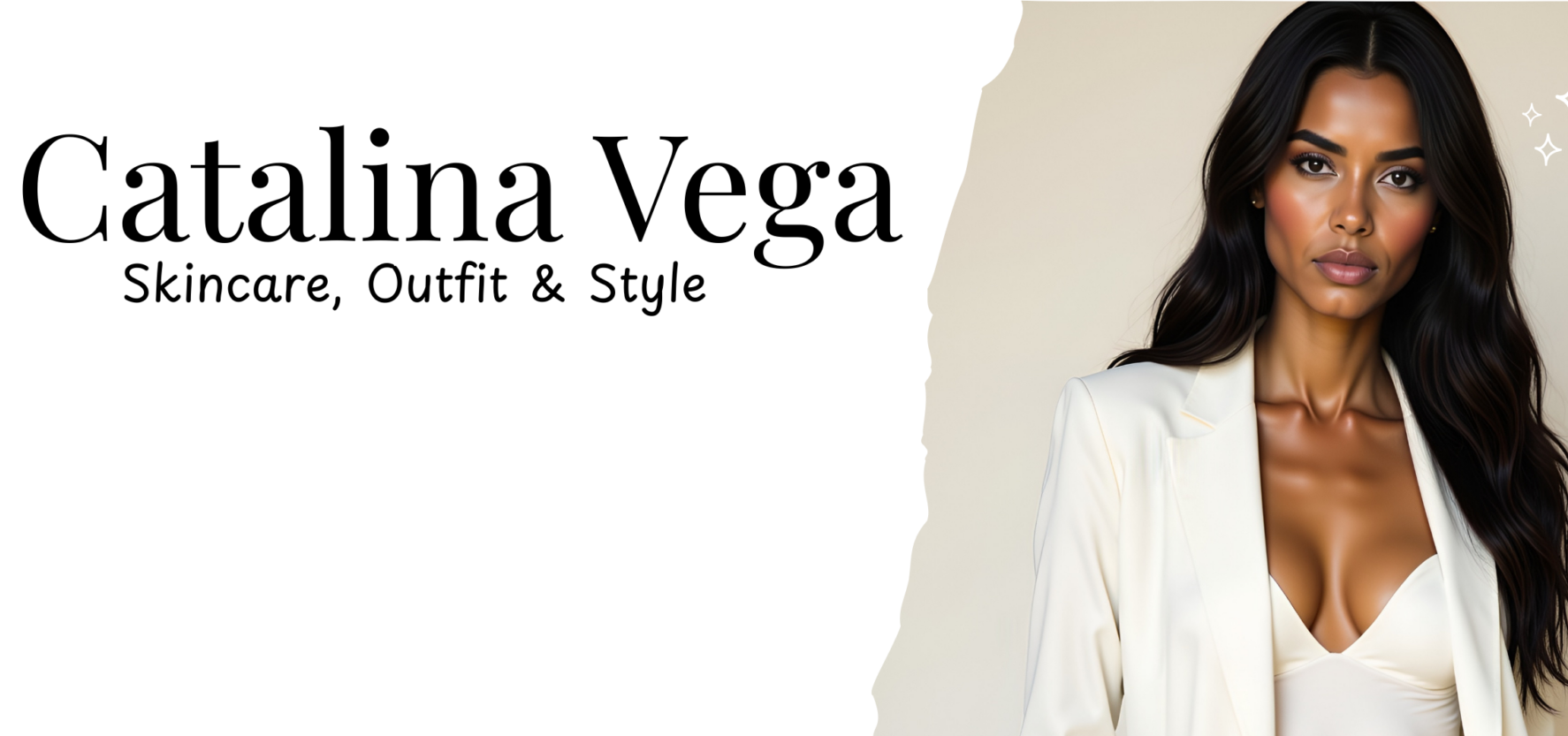Table of Contents
For centuries, people have turned to natural remedies to care for their strands. From Ayurvedic traditions to modern beauty routines, hair oils have played a key role in maintaining healthy locks. These best hair growth oils aren’t miracle cures, but they can create an optimal environment for stronger, shinier strands.
Understanding the basics is essential. For example, knowing what “ends” refer to in hair care helps you target specific areas for improvement. Whether you have fine, curly, or thick hair types, the right oil can make a difference.
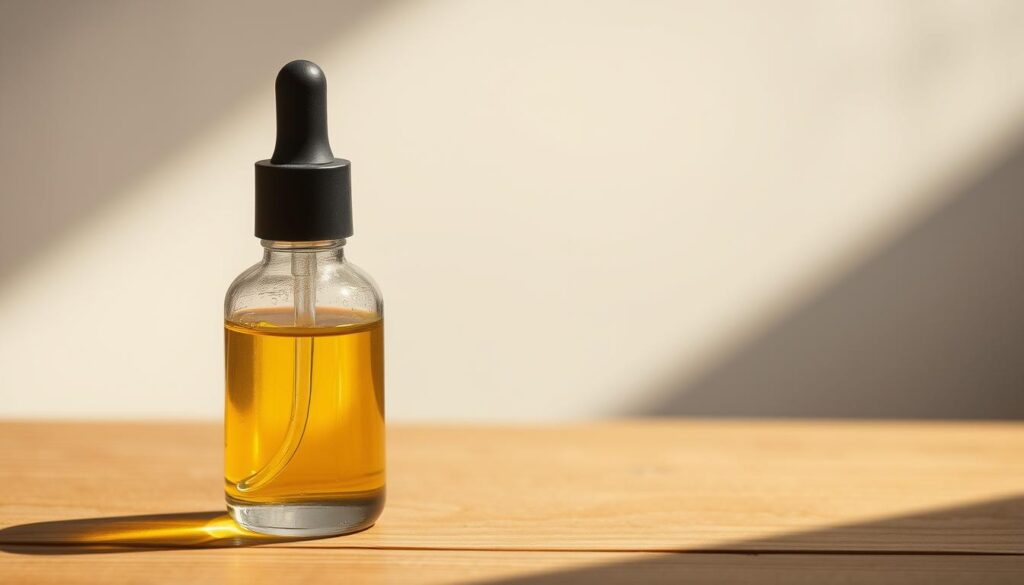
In this guide, we’ll explore the top 10 options that combine ancient wisdom with modern science. From rosemary to castor oil, each product has been tested by experts to ensure effectiveness. Let’s dive in and discover how these oils can transform your routine.
Key Takeaways
- Hair oils have been used for centuries in beauty rituals.
- They create a healthier scalp environment and stronger strands.
- Understanding terms like “ends” is crucial for proper care.
- Different hair types benefit from specific oils.
- Expert-tested options ensure quality and effectiveness.
Introduction to Best Hair Growth Oils
Healthy locks often start with the right natural products. These nourishing blends, often referred to as hair growth oils, are designed to support follicle health and maintain a balanced scalp. But what exactly are they, and why do they matter?
What Are Hair Growth Oils?
Hair growth oils are specialized blends of natural ingredients that nourish the scalp and strands. They often include plant-based extracts, vitamins, and essential oils. These products work by creating an optimal environment for follicles to thrive, promoting strength and shine.
One standout ingredient is castor oil, known for its anti-inflammatory properties. It helps soothe the scalp while locking in moisture. Understanding these oils is the first step to choosing the right one for your needs.
Why They Matter for Your Hair
The condition of your scalp plays a crucial role in the health of your strands. A well-moisturized scalp prevents dryness and irritation, which can lead to breakage. Hair growth oils help maintain this balance, ensuring your locks stay strong and vibrant.
Historically, these oils have been used in beauty rituals across cultures. Today, modern science has validated their benefits, blending tradition with innovation. Whether you’re looking to repair damage or enhance shine, these oils offer a natural solution.
| Historical Use | Modern Application |
|---|---|
| Ayurvedic practices using herbal oils | Clinically tested formulas for follicle health |
| Castor oil for scalp nourishment | Castor oil in anti-inflammatory blends |
| Natural remedies for shine and strength | Scientific advancements in moisture retention |
By combining ancient wisdom with modern research, hair growth oils offer a timeless solution for healthier strands. Whether you’re new to these products or a seasoned user, understanding their role can transform your routine.
The Science Behind Hair Growth Oils
Science-backed formulas are reshaping how we care for our locks. These products combine ancient wisdom with modern research to deliver visible results. But what makes them so effective? Let’s dive into the active ingredients and their roles.
Key Active Ingredients and Their Roles
Natural products often include plant-based extracts, vitamins, and essential oils. These ingredients work together to nourish your scalp and strands. For example, coconut is a standout ingredient known for its deep moisturizing properties.
Other key components include rosemary, which improves circulation, and castor oil, which soothes the scalp. Each ingredient plays a specific role in creating a healthier environment for your strands.
How Oils Stimulate Hair Follicles
These products penetrate the strands, delivering essential nutrients directly to the scalp. This process helps stimulate follicles, promoting stronger and healthier growth. Ingredients like coconut also protect the fibers, reducing breakage over time.
Dermatologists agree that certain active ingredients can improve circulation and reduce irritation. By maintaining a balanced scalp, these oils ensure your strands stay vibrant and resilient.
Best hair growth oil: What to Look For
Decoding product labels is the first step to finding the perfect match for your needs. With so many options available, understanding what’s inside the bottle can make all the difference. Let’s break down what to look for to ensure you’re getting the most out of your treatment.
Understanding Product Labels
Not all products are created equal. Reading labels carefully helps you identify key ingredients like coconut oil, known for its deep moisture retention. Look for transparency in the ingredient list—this ensures you’re avoiding unwanted additives and focusing on natural benefits.
Different types of oils cater to specific needs. Some are lightweight, while others are richer in texture. Knowing your hair’s requirements helps you choose the right formulation. For example, if your strands are prone to dryness, a product with hydrating ingredients like coconut oil can work wonders.
Here are a few tips to keep in mind when evaluating labels:
- Check for natural ingredients that align with your hair goals.
- Avoid products with long lists of chemicals or artificial fragrances.
- Look for certifications or endorsements from trusted experts.
By taking the time to understand product labels, you can make informed choices that support healthier, stronger strands. It’s all about finding the right balance of ingredients that work for you.
Top Ingredients That Promote Hair Health
Natural ingredients have long been trusted for their ability to enhance scalp and strand health. From ancient remedies to modern formulations, certain components stand out for their nourishing properties. Let’s explore the key ingredients that make a difference.
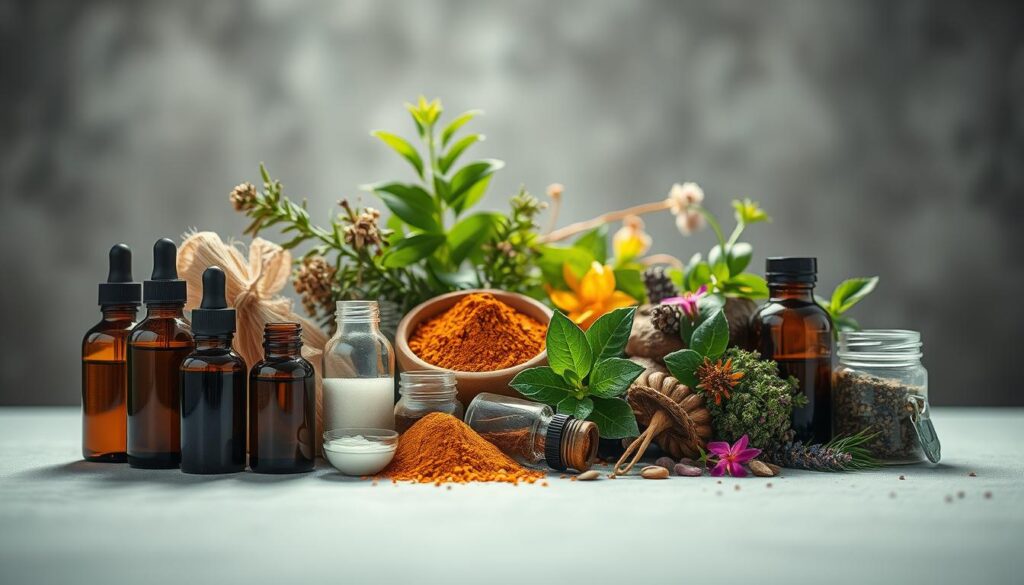
Coconut, Castor, and Argan Oils
These three oils are staples in many care routines. Coconut oil is known for its deep hydration, locking in moisture to prevent dryness. It’s a favorite for those with dry or damaged strands.
Castor oil is another powerhouse. Its anti-inflammatory properties soothe the scalp, while its rich texture strengthens strands. It’s often used to promote thickness and reduce breakage.
Argan oil, often called “liquid gold,” is packed with antioxidants. It protects the scalp and adds a natural shine. This lightweight oil is perfect for all types, from fine to thick.
Botanical Extracts and Their Benefits
Botanical extracts bring a natural boost to your routine. Ingredients like rosemary and peppermint improve circulation, encouraging healthier growth. They also reduce irritation, making them ideal for sensitive scalps.
Aloe vera is another standout. It hydrates the scalp and soothes irritation, creating a balanced environment for strands to thrive. These extracts are often found in trusted brands, ensuring quality and effectiveness.
| Ingredient | Benefits |
|---|---|
| Coconut Oil | Deep hydration, prevents dryness |
| Castor Oil | Soothes scalp, strengthens strands |
| Argan Oil | Adds shine, protects scalp |
| Rosemary Extract | Improves circulation, reduces irritation |
| Aloe Vera | Hydrates and soothes scalp |
By understanding these ingredients, you can choose products that align with your needs. Whether you’re looking to hydrate, strengthen, or protect, these natural components offer a reliable solution.
Selecting the Right Hair Oil for Your Hair Type
Your hair type plays a big role in determining the right product for you. Whether your strands are curly, fine, or somewhere in between, understanding your unique needs is key to achieving the best results. Trichologists emphasize tailoring your choice to your specific hair health and porosity.
Curly vs. Fine Hair Considerations
Curly and fine strands have different needs. Curly hair often requires richer, more hydrating blends to combat dryness and maintain definition. On the other hand, fine strands benefit from lightweight formulas that won’t weigh them down.
For curly hair, argan oil is a popular choice. It’s packed with antioxidants and adds shine without leaving a greasy residue. For fine hair, jojoba is a great option. Its lightweight texture mimics the scalp’s natural oils, promoting balance and health.
Low Porosity vs. High Porosity Essentials
Porosity determines how well your strands absorb moisture. Low porosity hair has tightly closed cuticles, making it harder for oils to penetrate. High porosity hair, on the other hand, absorbs moisture quickly but loses it just as fast.
For low porosity strands, lighter seed oils like grapeseed work well. They’re easy to absorb and won’t sit on the surface. High porosity hair benefits from richer oils like castor, which help lock in moisture and repair damage.
Here are a few tips to keep in mind:
- Test your porosity by placing a strand in water—if it floats, you likely have low porosity; if it sinks, it’s high porosity.
- Choose oils that match your hair’s absorption needs for better results.
- Experiment with blends to find the perfect balance for your hair health.
Hair Oil Application Techniques
Applying oils correctly can transform your care routine. Whether you’re prepping for a wash or maintaining daily shine, the right techniques make all the difference. Let’s explore how to use these nourishing blends effectively.
Pre-Wash Treatments
Pre-wash treatments are a game-changer for combating dryness and frizz. Start by applying a small amount of oil to your scalp and strands. Focus on the mid-lengths and ends, where split ends and breakage often occur.
Massage the oil into your scalp using gentle circular motions. This enhances absorption and stimulates circulation. Leave it on for at least 30 minutes before shampooing. This method locks in moisture and prepares your strands for cleansing.
Daily Use Tips
Incorporating oils into your daily routine can maintain shine and prevent dryness. Use just a few drops to avoid weighing down your strands. Warm the oil slightly between your palms before applying.
Target areas prone to frizz or split ends. For curly hair, argan oil works wonders, adding definition without greasiness. For fine strands, castor oil provides lightweight nourishment.
Remember, a little goes a long way. With the right technique, even a few drops can make a noticeable difference in your hair’s health and appearance.
Celebrity-Endorsed and Expert-Recommended Formulas
When it comes to achieving healthier strands, professional insights can make all the difference. Celebrity-endorsed and expert-recommended formulas, like those from Vegamour and Kerastase, combine star power with scientific backing. These treatments are designed to deliver visible results while addressing specific concerns like dryness and breakage.
Insights from Hairstylists and Dermatologists
Hairstylists and dermatologists often highlight the effects of key ingredients like rosemary oil. This powerful extract is known to protect hair by improving circulation and strengthening hair follicles. Experts recommend using a small amount of these concentrated formulas for maximum benefit.
For example, Vegamour’s GRO+ Advanced line incorporates seed oil blends that nourish the scalp and promote thickness. Kerastase, on the other hand, uses patented formulas to lock in moisture and repair damage. Both brands are trusted by professionals for their transformative results.
Here’s how you can integrate these expert-approved treatments into your routine:
- Apply a few drops of rosemary oil to your scalp before bed to stimulate hair follicles overnight.
- Use a lightweight seed oil blend as a daily leave-in treatment to protect hair from environmental stressors.
- Incorporate a weekly deep-conditioning mask with ingredients like argan or castor oil for added hydration.
By following these expert tips, you can achieve healthier, shinier strands in a practical and effective way. Whether you’re new to these products or a seasoned user, professional advice can elevate your routine.
Budget-Friendly Hair Oils That Work
Affordable options can still deliver impressive results for your strands. You don’t need to spend a fortune to find products that nourish and protect. Many budget-friendly formulas are packed with essential ingredients that rival their pricier counterparts.
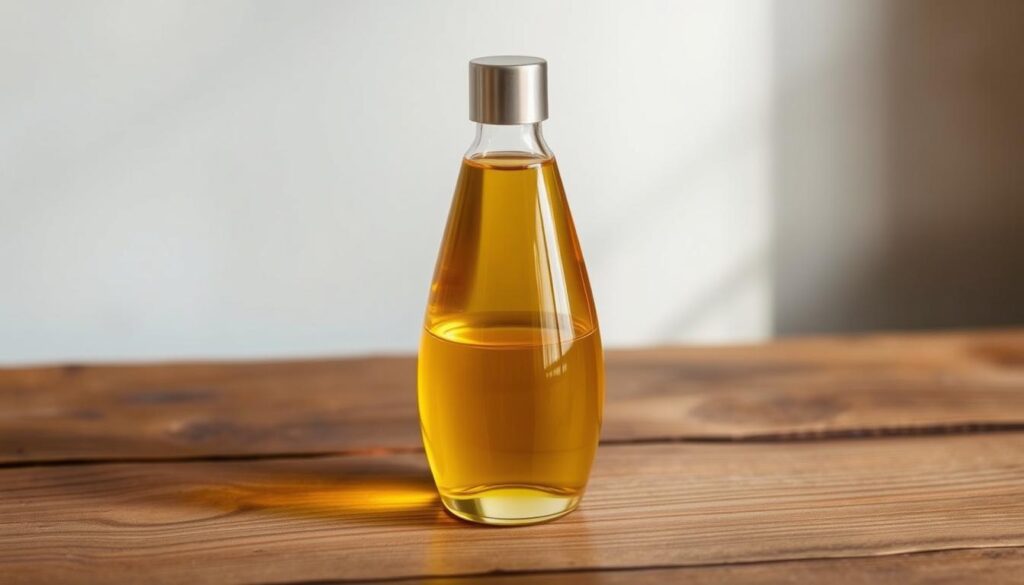
Testers have noticed significant improvements in texture and reduced breakage with these cost-effective choices. From lightweight blends to richer formulas, there’s something for every need. The key is to focus on quality ingredients rather than the price tag.
Here’s how to find value without compromising on performance:
- Look for natural ingredients like argan or castor oil, which are often affordable yet highly effective.
- Check reviews from real users to gauge performance and results.
- Opt for smaller brands that offer high-quality formulas at lower prices.
Don’t let a tight budget hold you back. With the right approach, you can achieve healthier, shinier strands without overspending. Give these budget-friendly options a try—you might be surprised by the results!
Premium Hair Oil Investments for Visible Results
Investing in premium products can elevate your care routine to the next level. While they may come with a higher price tag, the results often justify the cost. Advanced formulations in these oils are designed to tackle specific concerns, from thinning strands to scalp sensitivity.
Evaluating Price Versus Performance
When choosing a premium oil, it’s essential to weigh the cost against the benefits. Higher-priced products often include concentrated ingredients that deliver superior results. For example, formulas enriched with botanical extracts can address issues like hair loss more effectively than budget options.
Experts agree that investing in quality can lead to long-term improvements. “Premium oils often contain active ingredients that nourish the scalp and strengthen strands,” says a leading dermatologist. This makes them a worthwhile addition to your routine.
Here’s what to consider when evaluating premium options:
- Advanced formulations that target specific concerns like thinning or dryness.
- Ingredients like argan or castor oil, known for their nourishing properties.
- Expert endorsements and clinical testing for added credibility.
While the initial cost may be higher, the long-term benefits often outweigh the expense. Premium oils can transform your routine, delivering visible results that cheaper alternatives may not achieve. If you’re willing to invest, these products are a game-changer for healthier, shinier strands.
Oils for Mitigating Hair Loss and Enhancing Growth
Combatting hair fall starts with understanding the science behind effective ingredients. Research and expert testing confirm that certain oils help reduce shedding while strengthening follicles. These natural solutions are packed with anti-DHT properties, making them a go-to for those seeking thicker, fuller strands.
Anti-DHT Ingredients and Follicle Strengthening
DHT, or dihydrotestosterone, is a hormone linked to hair loss. Anti-DHT ingredients like saw palmetto and pumpkin seed oil work to block this hormone, reducing shedding and promoting healthier growth. These oils penetrate the scalp, nourishing follicles and creating a stronger foundation for strands.
Experts emphasize the role of natural extracts in this process. “Ingredients like rosemary and peppermint improve circulation, which is crucial for follicle health,” says a leading dermatologist. These extracts not only reduce irritation but also encourage thicker, more resilient strands.
Here’s what to look for when selecting products aimed at reducing hair fall:
- Anti-DHT ingredients like saw palmetto or pumpkin seed oil.
- Natural extracts such as rosemary or peppermint for improved circulation.
- Lightweight formulas that won’t weigh down your strands.
| Ingredient | Benefits |
|---|---|
| Saw Palmetto | Blocks DHT, reduces shedding |
| Pumpkin Seed Oil | Strengthens follicles, promotes thickness |
| Rosemary Extract | Improves circulation, reduces irritation |
| Peppermint Oil | Stimulates scalp, encourages growth |
By incorporating these oils into your routine, you can tackle thinning areas with confidence. Whether you’re dealing with mild shedding or more significant loss, these natural solutions offer a practical and effective approach to healthier strands.
Nourishing Treatments for Split Ends and Breakage
Split ends and breakage can be frustrating, but the right treatments can make a world of difference. Hydration is the secret to repairing damaged strands and restoring their health. When your locks lack moisture, they become brittle and prone to splitting. That’s where moisture-rich formulas come in.
Moisture-Rich Oils for Repair
A well-formulated oil can work wonders for damaged strands. These treatments penetrate deeply, sealing split ends and preventing further breakage. Ingredients like argan and castor oil are particularly effective. They lock in moisture, strengthen the fibers, and restore shine.
Test results show that these formulas can significantly reduce loss from split ends and breakage. By keeping your strands hydrated, they become more resilient and less likely to split. Regular use can transform even the most damaged locks.
Here’s how to incorporate these treatments into your routine:
- Apply a small amount of oil to damp strands, focusing on the ends.
- Use a wide-tooth comb to distribute the product evenly.
- Leave it on for at least 30 minutes before rinsing or leave it in for overnight repair.
With the right approach, you can say goodbye to split ends and hello to healthier, stronger strands. It’s all about finding the perfect formula for your needs and using it consistently.
Integrating Scalp Massagers with Hair Oils
Combining the right tools with nourishing products can transform your scalp care routine. Experts note that pairing oils with scalp massagers boosts circulation and improves absorption into follicles. This dynamic duo not only enhances the benefits of your treatment but also makes the process more enjoyable.
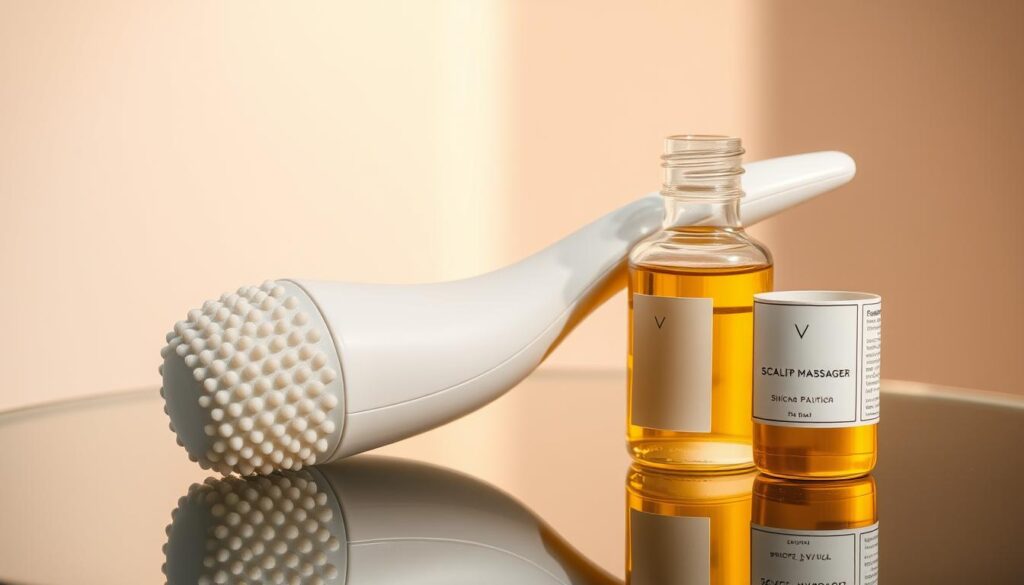
Techniques for Enhanced Scalp Stimulation
Using a massager alongside your oil treatment can significantly improve results. The physical act of massaging stimulates blood flow, which helps deliver nutrients to the follicles. This process also ensures the oil penetrates deeper, maximizing its effectiveness.
Here’s how to incorporate a massager into your routine:
- Start by applying a small amount of oil to your scalp. Focus on areas that need extra attention, like the crown or temples.
- Use a scalp massager in gentle, circular motions. Apply light pressure to avoid irritation but ensure the oil is evenly distributed.
- Spend 3-5 minutes massaging your scalp. This short session can lead to noticeable improvements in circulation and absorption.
By spending just a few minutes massaging, you can enhance the benefits of your oil treatment. This simple addition to your routine can make a big difference in the health and appearance of your strands.
Maintaining Hair Health Through Regular Use
Consistency is the cornerstone of achieving and maintaining healthy strands. Regular application of quality oils—rich in nourishing ingredients—can create lasting improvements in your locks. Whether you’re looking to strengthen, hydrate, or protect, integrating these products into your routine is key.
Nutrient-packed oils work best when used consistently. They help maintain a balanced scalp, reduce dryness, and prevent breakage. By making oils a part of your daily or weekly regimen, you can sustain the benefits and see noticeable changes over time.
- Strengthens strands by delivering essential nutrients to the scalp.
- Locks in moisture, reducing frizz and split ends.
- Improves shine and texture, leaving your locks looking vibrant.
Key ingredients like argan, castor, and rosemary play a vital role in maintaining hair health. These natural extracts nourish the scalp, promote circulation, and protect against environmental damage. With persistence, you can achieve healthier, shinier strands that feel as good as they look.
| Ingredient | Benefits |
|---|---|
| Argan Oil | Adds shine, protects against damage |
| Castor Oil | Strengthens strands, reduces breakage |
| Rosemary Extract | Improves circulation, promotes growth |
Remember, the key to success is consistency. By sticking to your routine and choosing the right products, you can enjoy the long-term benefits of healthier, more resilient locks. Start today and see the difference regular care can make!
How to Create a Custom Hair Oil Routine
Crafting a personalized routine can unlock the full potential of your strands. By tailoring your approach, you can address specific needs and achieve better results. Whether you’re dealing with dryness, breakage, or just want to enhance shine, a custom plan ensures your locks get exactly what they need.
Mixing Oils for Optimal Results
Combining different oils allows you to create a blend that targets multiple concerns. For example, mixing lightweight ingredients like jojoba with richer ones like castor can balance hydration without weighing down your strands. This approach ensures your hair gets a mix of nutrients for overall health.
Here’s a simple guide to get started:
- Choose a base oil like coconut or argan for hydration.
- Add a stimulating oil like rosemary or peppermint to improve circulation.
- Include a repairing oil like castor to strengthen strands.
Experiment with ratios to find what works best for your hair. Start with equal parts and adjust based on your needs.
Adjusting Your Routine for Seasonal Changes
Your hair needs change with the seasons, and your routine should too. In winter, opt for richer formulas to combat dryness and static. Ingredients like shea butter and castor oil can provide extra moisture during colder months.
In summer, switch to lighter oils like grapeseed or almond. These won’t weigh down your strands in humid weather. They also help protect against sun damage and keep your scalp balanced.
Here’s how to adapt your routine:
- Winter: Use thicker oils and apply more frequently to lock in moisture.
- Summer: Focus on lightweight oils and apply sparingly to avoid greasiness.
By adjusting your routine, you can keep your strands healthy and vibrant all year round. Customization is the key to achieving your best hair yet!
Modern Trends in Hair Oil Formulations
The beauty industry is evolving, and so are the formulations of nourishing products for your strands. Today’s innovations combine traditional wisdom with cutting-edge technology, creating solutions that are smarter and more effective than ever before.
One of the most exciting trends is the use of peptides and novel antioxidants. These ingredients are designed to promote faster regrowth while strengthening follicles. “Peptides are game-changers,” says a leading dermatologist. “They help repair damage and stimulate healthy growth at the cellular level.”
Another breakthrough is the integration of bioactive components. These advanced ingredients work deeply to nourish the scalp and strands, ensuring long-lasting benefits. Testing data shows that these formulations can significantly improve texture and reduce breakage.
Here’s what makes these modern trends stand out:
- Peptides for cellular repair and growth stimulation.
- Antioxidants to protect against environmental damage.
- Bioactive blends that deliver nutrients more effectively.
By staying updated on these innovations, you can elevate your care routine and achieve healthier, more resilient strands. The future of strand care is here—embrace it!
Conclusion
Choosing the right blend of natural extracts can transform your care routine. By focusing on key ingredients, you can unlock the full potential of your strands. Whether you’re targeting dryness, breakage, or simply enhancing shine, informed choices make all the difference.
We encourage you to combine expert advice with personal testing. Experiment with different blends to find what works best for your unique needs. Consistency is key—regular use of quality products ensures lasting results.
Finally, don’t forget to read labels carefully. Look for formulas rich in natural extracts like argan or castor oil. These ingredients nourish your scalp and promote healthier, stronger strands. With the right approach, you can achieve your goals and feel confident in your routine.
